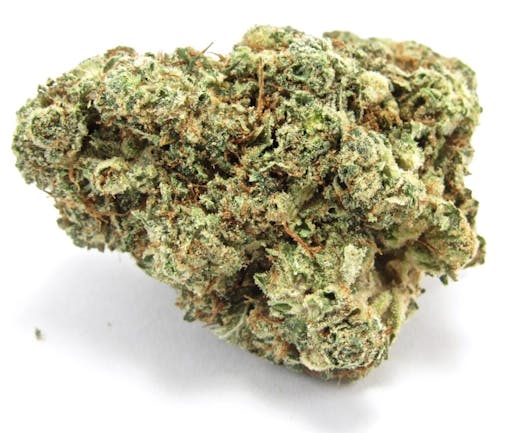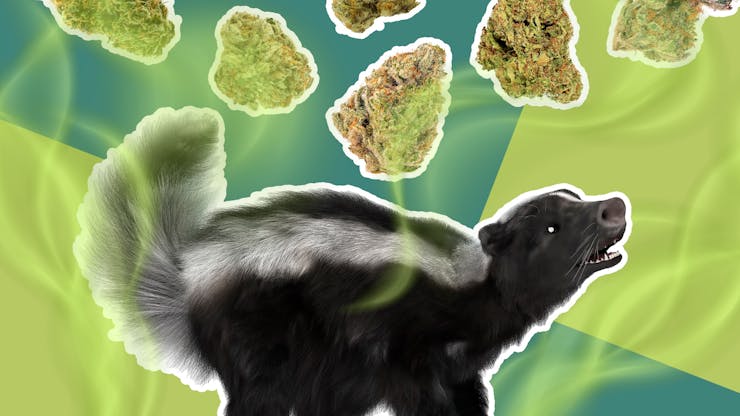Neuroscientist & plant chemistry researcher Dr. Nick Jikomes discusses the latest canna science, all about where the infamous “skunk” smell of weed comes from.
Many individual aroma notes can be detected when smelling marijuana, ranging from floral to fruity or earthy. We all have our preferences, but most cannasseurs would agree on one thing: any weed worth talking about should smell pungent. It should smell strongly and distinctly like weed, no matter what subtler accents are present.
Blue Dream, White Widow, and Gelato can be distinguished by smell by an experienced observer, but it’s their common core odor–the smell of weed–that we want to explain. What, exactly, is this pungent “weed smell” common to any strain grown with care? Where does it come from? Is it based on having high terpene content, or a particular constellation of terps? Or is there something else?
- Skunk, gas, and the perception of “good weed”
- Terpenes are not the answer
- Chemical basis of pungent smells in nature: Skunks & garlic
- Volatile sulfur compounds & the aroma of weed
- Which cannabis strains have the highest VSC content?
- Freshness & cannabis pungency
- Do cannabis VSCs have psychoactive effects and/or medicinal value?
Skunk, gas, and the perception of “good weed”

We can debate endlessly what “good weed” should smell like, but any non-casual consumer can tell you what it should not smell like. Good weed is always fresh weed, never old weed. Its initially pungent aroma quickly loses vigor as it sits around. In a matter of days, this pungency fades into something far less remarkable, smelling more and more like hay or dried lawn grass as time passes. Marijuana’s pungency is also commonly taken to be a proxy for its potency–fresh, well-cured bud doesn’t just smell different, it tastes and feels better.
Often described with words like “skunky” or “gassy,” that pungent cannabis aroma is specifically sought after by seasoned consumers. It’s also recognized (and frequently avoided) by non-consumers. Walking through the park, anyone can detect that distinctive skunk-like odor, which can linger and travel an impressive distance. And at times it really does smell like a skunk.
Terpenes are not the answer
Terpenes are a major class of aromatic compounds found within the essential oil of Cannabis plants, commonly thought to be the main driver of the aroma. They are definitely a core component, but we haven’t been able to cleanly explain people’s olfactory perception of weed with knowledge of terpene profiles alone. For starters, no single cannabis terpene has that pungent weed smell. Myrcene is earthy, limonene is citrusy, pinene smells like pine. None smells skunky. The typical explanation given for this is that the sense of smell is complicated, and the pungent weed smell must come from a complex bouquet of terpenes “working together.”
That explanation is not absurd, but I can tell you from several years in the cannabis industry that multiple groups have tried and largely failed to correlate people’s sensory perceptions (the way they say different strains smell) to terpene profiles. People do not consistently describe Terpene Profile A as gassy and Terpene Profile B as fruity. Despite this, they often do consistently agree that Strain A and Strain B are both more pungent than Strain C, even though the terpene profiles of each differ.
An alternative explanation might be that the pungent, skunky aroma does not arise from terpenes, but some other class of volatile compounds that Cannabis might produce.
Chemical basis of pungent smells in nature: Skunks & garlic
Perhaps instead of starting with Cannabis and trying to explain its pungent aroma in terms of volatile compounds we already know are there, we should instead identify other areas in nature where that kind of aroma is found, ask what compounds give rise to it, and then search for similar things in Cannabis.
Skunks are infamous for the pungent smell of the aerosol spray they use to defend themselves. We simply call this odor “skunk” and it’s evocative of the pungent aroma commonly associated with cannabis. This odor comes largely from something called Volatile Sulfur Compounds (VSCs), which are highly volatile and extremely potent–minuscule amounts can be detected by the nose.
Volatile Sulfur Compounds also underlie the pungent aroma of plants such as hops and garlic. What about Cannabis? Does it produce Volatile Sulfur Compounds similar to those found elsewhere in nature?
Volatile sulfur compounds & the aroma of weed
I recently spoke to Dr. Iain Oswald, a chemist at Abstrax Tech who led a study investigating the origins of the skunk aroma in cannabis. Using ultra-sensitive methods of analytical chemistry, they identified several Volatile Sulfur Compounds in cannabis. These included some that had not previously been identified in nature, as well as one nearly identical in chemical structure to a major VSC found in skunk aerosols.
Mixtures of these cannabis VSCs were able to emulate the smell of cannabis flower. The concentration of these cannabis VSCs varied dramatically across different cannabis strains. Even more interesting: VSC concentrations were highly correlated with the olfactory perceptions of humans. People were asked to rank the pungency of thirteen different cannabis samples. Not only did people tend to rank samples similarly in terms of overall pungency, but these rankings were highly predictive of the VSC content. The higher the VSC content, the more pungent the perceived weed aroma.
Which cannabis strains have the highest VSC content?

In Dr. Oswald’s study, some strains had high VSC content, and some had little to none. Strains with high VSC content, also rated as the most pungent, included various Gelato and OG strains. In contrast, Goudaberry and Black Jack did not have detectable VSC levels and were rated the least pungent.
Although VSCs are a separate class of chemical compounds from terpenes, VSC content appears to be correlated with terpene profiles. In a recent meeting at the annual American Chemical Society conference, Dr. Oswald overlaid his team’s data on cannabis VSCs with a study Leafly conducted in partnership with the University of Colorado, where we analyzed terpene profiles across tens of thousands of samples.
In our study, we identified three major “superfamilies” of high-THC cannabis cultivars, categorized based on terpene profiles. One of these families, characterized by high levels of terpinolene, also tends to have low VSC content. This includes many “Sativa” cultivars, including “Jack” strains (e.g. Jack Herer, Black Jack), “Golden” strains (e.g. Golden Goat, Golden Pineapple), and Lemon Haze & Super Lemon Haze.
The majority of commercial cannabis strains have other terpene profiles, characterized by higher levels of things like β-caryophyllene and limonene. This includes everything from Gelato and GSC to GG4 and most OG strains. Strains with these terpene profiles tend to have high VSC levels.
Learn more about cannabis science directly from the experts.
Freshness & cannabis pungency
Dr. Oswald’s study also found that the Volatile Sulfur Compounds in cannabis tend to peak when Cannabis flower is dried and cured, falling off very rapidly thereafter (even faster than terpene content). This may explain why the characteristic aroma of dried cannabis fades so quickly without careful storage and why many consumers are able to quickly gauge freshness by smell.
Do cannabis VSCs have psychoactive effects and/or medicinal value?
It is currently unknown whether cannabis VSCs (volatile sulfur compounds) impact the psychoactive effects of cannabis or have medicinal value. Because they are present at such low levels, they have been largely overlooked until recently. Determining their pharmacological properties and testing whether they contribute to the psychoactive or medicinal effects of cannabis will be an important area of future research.
To learn more about the science of cannabis VSCs, check out my recent conversation with Dr. Iain Oswald:





